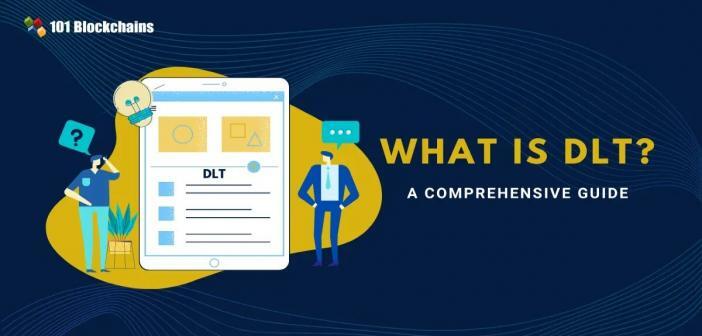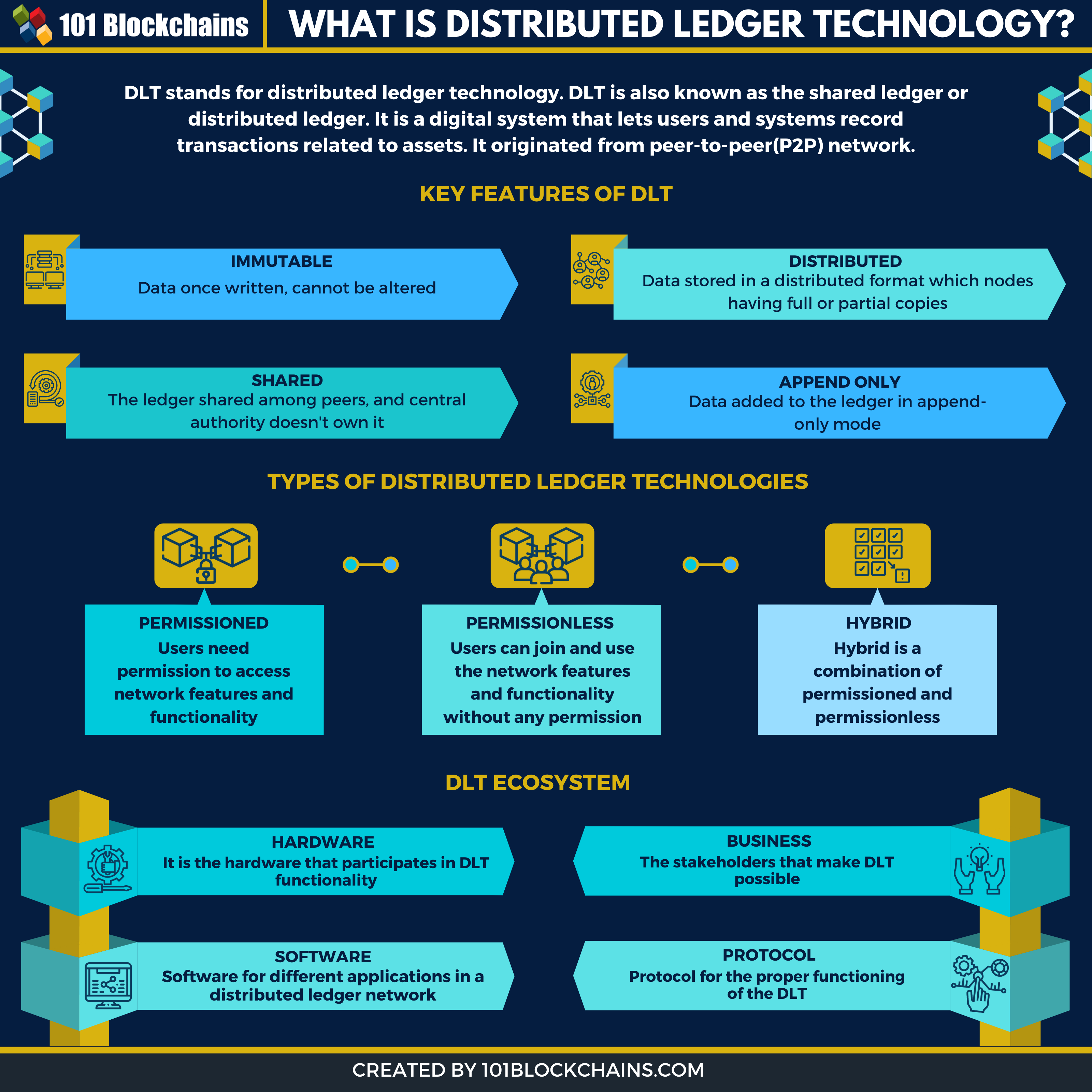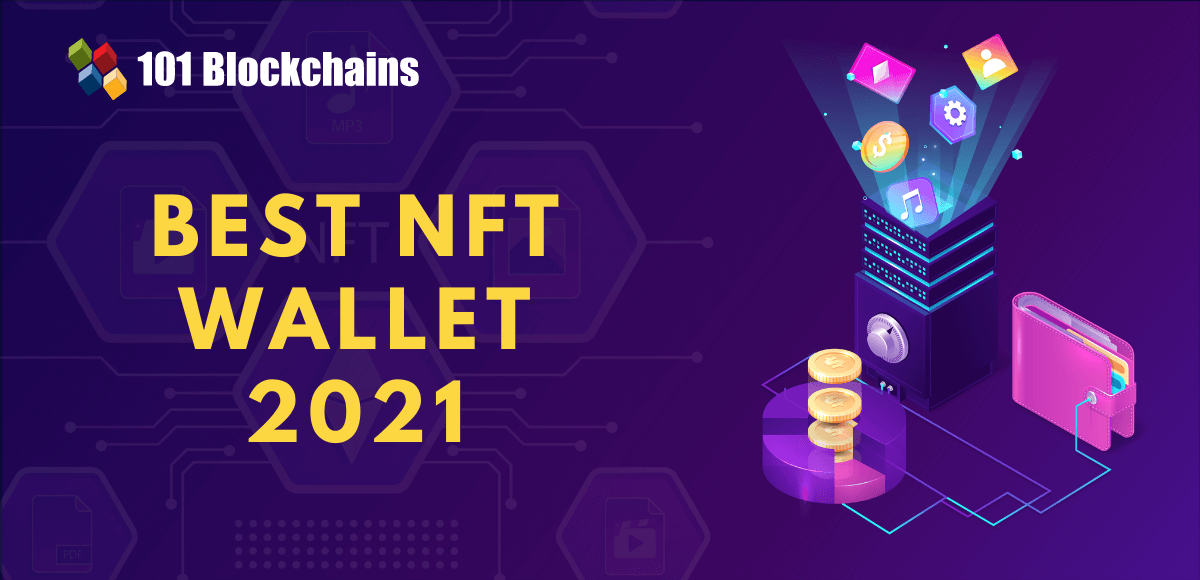Learn how blockchain truly works, master key definitions, and uncover what makes smart contracts so "smart." Dive into the fundamentals, gain valuable insights, and start your blockchain journey today!

- Reviews
101 Blockchains
- on July 06, 2021
What is DLT (Distributed Ledger Technology) ?
What is DLT?
For starters, DLT stands for Distributed Ledger Technology. It is also known as a “shared ledger” or simply distributed ledger.
It is a digital system that lets users and systems record transactions related to assets. A distributed ledger technology stores the information at multiple locations at any given point of time.
DLT, unlike traditional databases, does not have any central place to store information. This is what differentiates it from a traditional database. The decentralization feature also provides better security, transparency, and trust among parties using it.
So, where DLT originates from?
At the core, DLT originates from the peer-to-peer(P2P) network. In any P2P network, peers communicate with each other without the need for a centralized entity. Technically, a distributed ledger technology is possible through a peer-to-peer network. A consensus algorithm is utilized to make decentralization work.
Right now, distributed ledger technologies are very popular. After all, they are changing the land space of different industries out there. One of the technologies that are under the umbrella of DLT is blockchain.
Build your identity as a certified blockchain expert with 101 Blockchains’ Blockchain Certifications designed to provide enhanced career prospects.
We will discuss it soon.
Please include attribution to 101blockchains.com with this graphic. <a href='https://101blockchains.com/blockchain-infographics/'> <img src='https://101blockchains.com/wp-content/uploads/2020/07/what-is-DLT.png' alt='what is DLT='0' /> </a>
But, before we go and discuss different aspects of DLT, let’s first learn about the origins of ledgers.
Origin of Ledgers
The best way to define ledgers is to describe them as a way to store information or transactions.
Back in millennia, ledgers existed in paper form.
With new technology and approach, ledgers got digitized where the assets are now digitized through a detailed process and then stored in the network.
These computerized ledgers are at the core of the innovation now as they provide industries the way to solve problems that were not possible to solve using traditional centralized solutions.
Right now, there are multiple use-cases of distributed ledger technologies which we have discussed in detail on our site, 101Blockchains.com.
Also, if you check out the current scenario, almost every service out there uses centralization as a way to authenticate transactions in the ledgers. Banks, for example, are prime examples of it. However, banks are now working towards a bright future by adopting DLT.
With changes in cryptography and its implementation to ledger technology, it is now easy to say that distributed ledger technologies are ready for mass adoption by consumers and businesses out there.
Want to become a Cryptocurrency expert? Enroll Now in Cryptocurrency Fundamentals Course
Key Features of DLT
A distributed ledger technology has some key features that make it unique compared to centralized ledger solutions.
In simple terms, a DLT is best defined as a replicated, synchronized, and replicated ledger which works in a distributed manner.
The key characteristics include:
- Immutable: A distributed ledger utilized cryptography to create immutable and secure storage. This ensures that the data once stored cannot be changed or altered.
- Append only: Distributed ledgers are append-only as they provide full transactional history. This is completely different compared to a traditional database where the data can be altered for the sake of functionality. However, that can lead to data changes and manipulation, both internally or by external factors.
- Distributed: Another key characteristic of the ledger is its distributed nature. Yes, there is no single place where the data is stored. Every peer has a copy of the ledger in most DLTs out there. Some DLTs such as Corda stored data in other ways.
- Shared: The ledger is not associated with one single entity. It is shared among nodes. Some nodes are responsible to have a full copy of the ledger while other nodes just have the necessary information to make them functional and efficient.
Types of Distributed Ledger Technologies
There are primarily three types of distributed ledger technologies out there.
- Permissioned
- Permissionless
- Hybrid
Let’s discuss each one of them briefly below.
-
Permissioned
Permissioned networks are private networks. They are designed to work in a closed ecosystem where the user needs to have access granted through a KYC procedure.
The users once validated can access the features of the permissioned network or permissioned distributed ledger systems. In a permissioned network, the validation nodes do the heavy lifting as they are responsible for validating the transactions within the network.
The network can also be designed to restrict a few users to have limited access to the network functionalities. This feature is very useful for businesses who want to take advantage of blockchain, but do not want to make their data public to everyone. After all, for a business, it is important to protect their important business data. That’s what makes them unique and keep their market position safe from their competitors.
-
Permissionless
Permissionless distributed ledger systems or networks are public networks. By definition, users do not need permission to participate in the permissionless network. The distributed ledger system is open to everyone for making transactions, validating blocks, and making other forms of interaction with the network.
The key here is freedom. The best example of a permissionless network is bitcoin itself. It was the first cryptocurrency that utilized blockchain technology – an implementation of DLT. Anyone can send bitcoin or receive it. There is no limitation on who can use it irrespective of the location, laws, and other factors that govern how transactions are carried out.
-
Hybrid
The last type of DLT that we are going to discuss is a Hybrid distributed ledger system. It combines both permissionless and permissioned networks and offers a network that benefits from both of them.
Hybrid DLTs are an excellent choice for businesses as they can decide on which aspects of the system they want to make public and which ones they want to keep private.
Learn the fundamentals of Blockchain through Blockchain Basics Flashcards
Role of Consensus Mechanism
At the core of any distributed ledger technology, there are consensus mechanisms. These mechanisms are the procedures and rules govern how the nodes in a distributed ledger network validate transactions.
Another thing that DLT technology is to decide which nodes are chosen for the validation purpose. So, when a new block is generated, it chooses the nodes and assigns them the task to validate the block. All of these are governed by the consensus mechanism chosen by the distributed network.
Also, if a network is permissionless, then the nodes compete with each other to validate the block.
Some of the popular consensus algorithms out there include Proof of Work, Proof of Stake, Delegated Proof of Stake, Byzantine fault tolerant-based, and so on.
-
Proof of Work (PoW)
Proof of Work is the most popular one. It utilizes energy-intensive computations that solve the puzzle set by the network. With time, the puzzle becomes more computationally complex and makes it hard for nodes to validate.
This is the problem that bitcoin is currently going through. Also, there is no one node that can do the computation, and hence the computational power is combined to solve the puzzle.
That’s why the reward for solving a block is distributed among the different players, giving everyone an incentive to participate in the process.
Want to become a bitcoin expert? Enroll Now: Getting Started with Bitcoin Technology
-
Proof of Stake(PoS)
Proof of Stake takes another route to solve the consensus problem. In PoS, nodes with an existing stake can participate in the consensus method. This alternative method is energy efficient and hence solves a lot of problems with PoW.
So, if a user decides if he wants to participate in the consensus method of a DLT which uses PoS, then he needs to invest to participate.
DLT Ecosystem
To get a better understanding of distributed ledger technologies, we also need to learn about its ecosystem. So, there are four different parts/aspects of a distributed ledger technology ecosystem. It includes the following:
- Hardware
- Software
- Business
- Protocol
Hardware
When it comes to hardware, a DLT ecosystem needs nodes that can act as storage devices, servers, or computers.
Also, the nodes can have three modalities:
- Block producing validating nodes → Here, the block produces full validating nodes. These nodes then take part in the consensus method and have a copy of the entire distributed ledger including all the transactions.
- Partial/light nodes → Partial/light nodes have a limited transaction list which makes them functional and takes part in the network.
- Non-block producing full validating nodes → In the case of a non-block, they produce full validating nodes that do not participate in the consensus process. They also contain the entire distributed ledger with all the possible transactions.
Software
When it comes to software, DLT utilizes different types of software applications. In the software ecosystem of a DLT, you can find the applications to be written using various programming languages including Java, C++, Rust, Go, JavaScript, Python and so on. As you can see, DLTs are not language-specific and can work with any programming language or tools based on the requirement.
The choice of the programming language depends on the language’s weakness and strength.
When it comes to the applications running on DLT, it can be categorized as below:
- Financial → Here, manages and uses money
- Semi-financial → In this type, business process includes money but the main focus is to complete tasks.
- Non-financial → In this type, there’s no including money, and the business process’s main focus is completing tasks.
Business Development
When it comes to the business development aspect, DLT has to take care of the investors, users, corporations, developers, and block producers.
All the stakeholders have to use DLT-oriented apps, services, and solutions to complete their tasks. For example, investors invest in the organization by providing the necessary funds for the creation and management of the DLT ecosystem. Their focus is to ensure profit from the investment and also succeed in terms of mission or vision of the business.
Developers deal with the development of products, applications and services. They do it by utilizing the network and DLT protocols. They are also responsible for providing technical support.
Block producers take active participation in the DLT’s consensus method. They are full validating nodes and have a full copy of the distributed ledger.
Lastly, corporations use DLT to do their business activities and provide value to their end-users.
Protocol Development
The last aspect of the DLT that we are going to discuss is protocol development. This is where the DLT’s protocol is developed and managed. It is worked upon by academia and developers. This layer takes care of how the cryptographic keys interact with the network.
Distributed Ledger Implementations
Distributed ledger technology has seen multiple implementations over the years. However, there are a few implementations that have more impact than others.
Let’s discuss a few of them below.
-
Blockchain
One of the prime examples of distributed ledger implementations is the blockchain!
Blockchain is a distributed ledger technology that shook the world. In 2008, Satoshi Nakamoto introduced bitcoin to the world. It utilizes blockchain technology to the world, which enables peers to send and receive digital currency without the need for a centralized entity.
The peers managed the blockchain network.
When a transaction takes place, it is assigned to a block. To verify the transaction, the block is then mined by the
Yes, immutability is one of the key features of blockchain.
Another feature that makes blockchain so amazing is transparency. The transactions that are done through the blockchain can be traced and validated if needed. The type of blockchain used determines the level of transparency. For example, a private blockchain will only provide transparency to the users who are registered to the network. Anyone outside the network will not be able to view the transaction keeping the transparency limited.
For public networks, transparency can work differently.
-
Corda
Corda is one of the interesting open-source DLT projects out there, aimed at business. This means that it offers businesses strict privacy using smart contracts and also uses a DLT with a cost-effective approach.
Corda utilizes a different approach when it comes to transactions within the platform.
The transactions only to the peers participating in the transaction.
This approach saves a lot of time, energy, and cost when it comes to validating transactions. And, that’s why Corda is one of the best DLT solutions for businesses.
Want to learn the basic and advanced concepts of R3 Corda Development? Enroll Now: Beginner’s Guide to Corda Development
-
Ethereum
Ethereum is another amazing example of a distributed ledger technology implementation. Bitcoin, the first cryptocurrency implemented blockchain technology. However, it lacked perfection.
One of those flaws is the use of the Proof of Work consensus algorithm as it required a lot of energy to compute and validate transactions. In short, Proof of Work is not environmentally friendly.
Ethereum fixed it by providing an alternative consensus method known as Proof of Stake.
It also introduced smart contracts, a way to automate tasks within the network. This also gave rise to decentralized apps which can automate a large aspect of the requirement.
Want to learn the basic and advanced concepts of Ethereum? Enroll Now: Ethereum Development Fundamentals
Why DLT is important
Distributed ledger technologies are important. Their key features such as accessibility, impenetrability, and accountability make it so desirable to businesses out there. It is a way of record keeping that facilitates immutability, trust, and transparency to the nodes participating in the process.
Conclusion
There is no doubt that distributed ledgers are the future. After all, it offers an excellent feature set for the businesses out there. It also has the ability to solve core societal and economical problems that the world is currently suffering from.
*Disclaimer: The article should not be taken as, and is not intended to provide any investment advice. Claims made in this article do not constitute investment advice and should not be taken as such. 101 Blockchains shall not be responsible for any loss sustained by any person who relies on this article. Do your own research!







